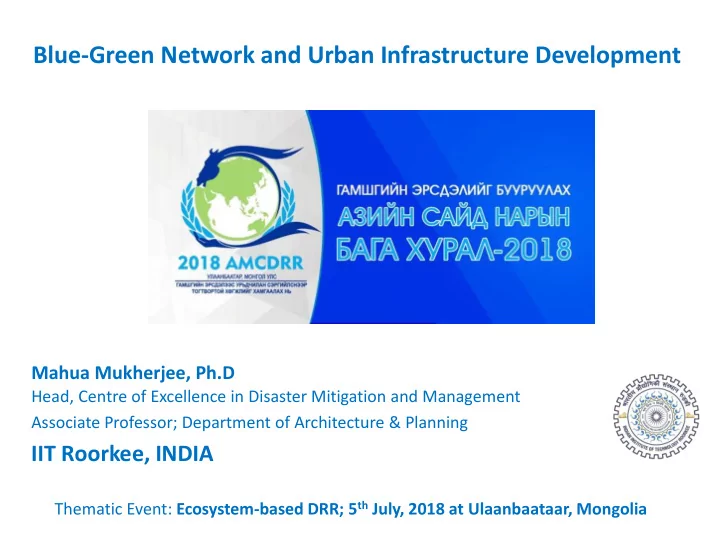

Blue-Green Network and Urban Infrastructure Development Mahua Mukherjee, Ph.D Head, Centre of Excellence in Disaster Mitigation and Management Associate Professor; Department of Architecture & Planning IIT Roorkee, INDIA Thematic Event: Ecosystem-based DRR; 5 th July, 2018 at Ulaanbaataar, Mongolia
Urban Risk 2002 Elbe River flood in Germany
Strom Xynthia in 2010, France Houses, such as these in La Faute-sur-Mer, were built in flood-prone areas Weichselgartner and Pigeon. The Role of Knowledge in Disaster Risk Reduction, Int Journal of Disaster Risk Sci (2015) 6:107 – 116
Which Way Forward ?
Ecosystem based Urban Planning Resilience Blue- Green Urban Infrastructure Urban Ecologist, Landscape Planning and Architecture- Ecosystem Services Green Engineering- De-stressing Urban Environment and provisioning Resiliency
BLUE-GREEN INFRASTRUCTURE E N S V E C O N O M I C A L C R I O A N L M R E S I L I E N C E N T A L
Urban Environment: energy and health security Heat wave, UHI Air Pollution removal, carbon sequestration Avoidance of emissions (reduced energy use) Blue-Green Network Wind regime- strong wind, pedestrian level discomfort Urban Water Ecology: water security Storm-water drainage- Urban Flood, Drought Water quality - Natural treatment Water balance, Water temperature Urban Agriculture: food security Soil protection - Soil stabilization, Increased permeability Nutrient cycle - Waste decomposition and nutrient cycling Production Urban Bio-diversity: habitat protection Species diversity, Habitat and corridors.
Blue-Green Infrastructure Network Scale: Macro, Meso, Local and Micro scale Elements: Bits of nature, Patch, Corridor and Matrix Conditions: Healthy, Under Threat, Degenerating and Potential,
Macro Scale Meso (matrix, corridor and patches)
Local (corridors and patches) Micro- (corridors, patches and bits of nature)
Blue-Green Network Challenges: Blue-Green Infrastructure Development, Design and Maintenance Culture Finding Opportunities even in small fragmented parcels Performance and benefit assessment quantitatively on long term basis
GUS-3CC Model Mukherjee, M. and Takara, (2018). ‘Urban green space as a countermeasure to increasing urban risk and the UGS - 3CC resilience framework’, International Journal for Disaster Risk Reduction, Volume 28, June 2018, Pages 854-861
Contextual Context to introduce the Blue- Green Infrastructure Medians Bio swale
Contextual Context to introduce the Blue- Green Infrastructure Once upon a time it was a flowing Channel! It can be revived like Cheonggyecheon River in Seoul
Blue-Green Infrastructure Proposal for Shivalik Apartments, an neighbourhood in IIT Roorkee Land cover Type Area (sqm) % Building Footprint 1750 29.17 Green cover 1050 17.50 Impermeable paving 3200 53.33 TOTAL 6000 100
Intervention OPTIONS
I: Contextual Concept for Blue-Green Infrastructure Permeable Parking Permeable Parking BioTech Triangle Permeable Pavements Shivalik Apartments
II: Core Competency after selecting Intervention STRATEGIES 1 2 1 2 Infiltration Basin 1 (Play Garden) Infiltration Basin 2 (Landscape) Porous pavement (Within Shivalik Apartment) Porous pavement (Parking Space in front of Shivalik*)
Intervention 1 : Infiltration Trench Source: River Valley LID BMP
III. Calculating Contribution: After Intervention in Shivalik Apartments Neighbourhood Intervention Type Effective surface area Effective (sqm) Volume (cu. m) Infiltration Basin 1 (Play Garden) 300 180 Infiltration Basin 2 (Landscape) 580 240 Porous pavement (Within Shivalik Apartment) 3200 182 Porous pavement 800 159 (Parking Space in front of Shivalik*) TOTAL 4880 761 Excess runoff from this Land cover Type Area (sqm) % neighbourhood will be reduced Building Footprint 1750 29.17 to two times in a year Green cover 1050 17.50 Permeable paving 3200 53.33 TOTAL 6000 100
Comparison of meteorological factors and comfort indices of Simulated Scenario Dr. Bhaskar De, 2018 Source: Doctoral Work of Urban Heat Island Study
Blue-Green Network Planning Approach Intervention Healthy Under Threat Degenerating Potential Immediate Protection Defensive Offensive Opportunistic Intermediate Preventive Defending Remedial or Integration measures development restorative with pressure measure Transportation and utility infrastructure Long-term Advocacy Connect Capacity Share Building
INDIAN INSTITUTE OF TECHNOLOGY ROORKEE Thank You! Email: mahuafap@iitr.ac.in
Recommend
More recommend